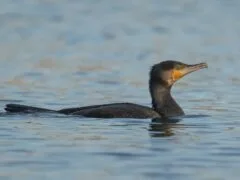The great cormorant (Phalacrocorax carbo) is a large, widely distributed waterbird known for its versatile hunting skills, striking black plumage, and distinctive wing-drying posture. It inhabits coastal and inland waters across Europe, Asia, Africa, Australia, and parts of North America, thriving in both marine and freshwater environments. An agile diver, it hunts fish with precision, […]
Category: Suliformes
Why the Cormorant can’t speak properly
Txamsem went walking, not knowing which way to turn. He went toward the sea; and, behold! he saw a house some distance away. He came near, entered, and sat down on one side of the fire. A man was there with his wife. This was the house of Chief Cormorant. The man’s wife arose and […]
Bird stories, Double-crested Cormorant (Phalacrocorax auritus)
The Kwakiutl coastal Indians of British Columbia say the birds did not select their own costumes, but that one of their ancestors painted all the birds he found at a certain place. When he reached the cormorant his colors were exhausted and he had only charcoal left, hence the cormorant is wholly black. A favorite […]
Bird stories, Great Cormorant (Phalacrocorax carbo)
In Greek folklore fables the cormorant was once a wool-merchant. He entered into a partnership with the bramble and the bat, and they freighted a large ship with wool. She was wrecked and the firm became bankrupt. Since that disaster the bat skulks about until midnight to avoid his creditors, the cormorant is forever diving […]
Bird stories, Brandts Cormorant (Phalacrocorax penicillatus)
Native dancers throughout California commonly blow bird bone whistles to accompany their movements. The shrill sound of the whistles was not appreciated by the 18th century Spanish explorer Pedro Fages, who encountered them among the Chumash. These people have been playing bird bone whistles for 3000 years, up to the present day. Archaeological examples include […]
Pseudo-eggs of brown sula leucogaster andblue-footed s. nebouxii boobies in the gulf of california, mexico
Brown Booby (Sula leucogaster) Science Article 4 abstract Pseudo-eggs, foreign round objects, notably eggs of other speciesor pebbles, are common in some ground-nesting species, and havebeen reported especially in larids (Sugden 1947, Twomey 1948,Coulter 1980, Conover 1985). As many as 10% of Ring-billedGull Larus delawarensis nests in Washington, USA includedpseudo-eggs (Conover 1985). The nests of […]
Distribution of nests of the brown booby (sulaleucogaster) in relation to the inclination ofterrain
Brown Booby (Sula leucogaster) Science Article 5 abstract species of the Sulidae family, which comprisesgannets and boobies (Carboneras 1992).Brown Boobies are pan-tropical birds thatnest on a wide variety of habitats (Dorward1962a, 1962b; Skutch 1976, Nelson 1978).Brown Boobies nest on much steeper terrainthan most boobies and gannets (Nelson 1978,Carboneras 1992); for this reason, it seemsthat this […]
Weights, hematology, and serum chemistry of free-ranging brown boobies (sula leucogaster) in johnston atoll, central pacific
Brown Booby (Sula leucogaster) Science Article 13 abstract Hematologie and serum chemistry values are reported for 105 brown boobies (Sula leucogaster) from Johnston Atoll, Central Pacific. Hematocrit, estimated total plasma solids, total and differential white cell counts, serum glucose, calcium, phosphorus, uric acid, total protein, albumin, globulin, aspartate aminotransferase, and creatinine phosphokinase were analyzed. H?matologie […]
Phylogeography of Sula: the role of physical barriers to gene flowin the diversification of tropical seabirds
Brown Booby (Sula leucogaster) Science Article 11 abstract We examined mitochondrial cytochrome b sequence variation in masked Sula dactylatra,red-footed S. sula, and brown S. leucogaster boobies sampled from islands inthe central and eastern Pacific Ocean and in the Caribbean Sea. Each species showeda different phylogeographic pattern. Whereas haplotypes in masked and red-footedboobies were shared across […]
Dna fingerprinting and parentage in masked (sula dactylatra) and brown (s. leucogaster) boobies
Brown Booby (Sula leucogaster) Science Article 10 abstract Masked Booby (Sula dactylatra) and Brown Booby (S. leucogaster) are pantropical seabirds. These species are socially monogamous. Thus, males and females have a high investment in parental care. In this work, field observations and DNA fingerprinting were applied to investigate the breeding system of both species. Two […]

